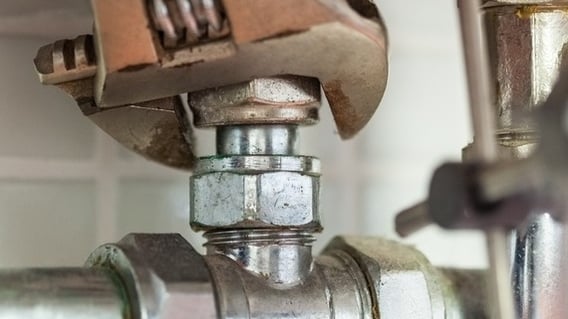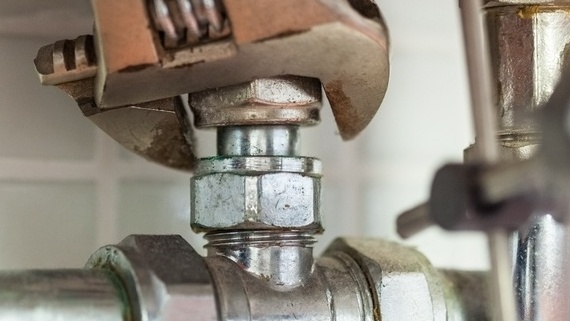
Changes to the approved code of practice, which took place a few years ago, mean that some people are still unaware of the regulatory requirements regarding Thermostatic Mixing Valves (TMVs) and TMV maintenance. Here’s our guide to everything you need to know about TMVs and how they should be serviced.
What is a Thermostatic Mixing Valve (TMV)?
TMVs accurately control water temperatures for bathing, showering, hand-washing and bidets. They are designed to maintain the desired water temperature, even when the incoming water pressures/flow rates change. By contrast, a mechanical mixing valve cannot adjust to changes in supply temperature, pressure or flow rate.
How does a TMV work?
Hot and cold water entering the valve is mixed to a temperature pre-selected by the user or installer. A thermally sensitive mechanism within the valve automatically proportions the amount of hot and cold water entering to produce the required blend. The mechanism then automatically compensates for any reasonable variations in supply pressures or temperatures within the design range to maintain the pre-selected temperature.
In the event of cold water supply failure, the thermostatic mixing mechanism will automatically shut down the flow to prevent discharge of dangerously hot water. The flow will also be shut down in the event of a hot water supply failure to prevent thermal shock. In the event of a sudden supply temperature increase (‘spike’), the TMV will quickly (but not absolutely instantly) adapt and deliver water at a safe temperature.
Why are TMVs important for safety?
Over three quarters of severe scalds are suffered by children under five years of age, and almost three quarters of the fatalities are people aged 65 and over. By limiting water temperature and stopping sudden increases in water temperature, TMVs help to prevent scalding, which can cause very serious and even fatal injuries. Hot bath water is responsible for the highest number of fatal and severe scald injuries in the home. Every year around 20 people die as a result of scalds caused by hot bath water and a further 570 suffer serious scald injuries.
Young children and older people are most at risk from bath water scalds because their skin is thinner and therefore less tolerant to higher water temperatures than that of other age groups. As a result, they sustain scalds more quickly, at lower water temperatures and often with a greater depth of burn.
People with a reduced ability to perceive risk or react to hazardous situations – for example those with mental or physical disabilities – are also at greater risk of injury. TMV maintenance helps to protect from scalding injuries.
What are the regulatory requirements?
From April 2010, England and Wales joined Scotland in requiring, as part of the building regulations, the control of hot water temperature to a safe maximum at the bath outlet in domestic bathrooms, which can be achieved by the fitting of a thermostatic mixing valve.
TMV2 states that “It is a requirement that all TMV2 approved valves shall be verified against the original set temperature results once a year. When commissioning/testing is due the following performance checks shall be carried out - measure the mixed water temperature at the outlet, carry out the cold water supply isolation test by isolating the cold water supply to the TMV, wait for five seconds if water is still flowing check that the temperature is below 46°C. If there is no significant change to the set outlet temperature (±2°C or less change from the original settings) and the fail-safe shut off is functioning, then the valve is working correctly and no further service work is required.”
What is required by TMV2 is an annual functionality check, but we also recommend an annual preventative servicing. Several factors may determine the required service frequency of a TMV, most notably water hardness and frequency of use.
TMV3
TMV3 valves must also receive a regular in-service test to check they are performing adequately. If they are not, the valve must be serviced. In the absence of other instructions or guidance, the regime described in D 08 (an NHS Model Engineering Specification) should be used. D 08 states that the first test must take place 6-8 weeks after commissioning, and the second after 12-15 weeks.
Following this, there is no fixed required test frequency, but the valve should be tested at intervals between which there is shown to be little or no change in mixed water temperature. Depending on the change in mixed water temperature between commissioning and the second test, D 08 recommends the third test to take place between 18 and 28 weeks after commissioning.
What happens during TMV servicing?
Servicing will entail checking the TMV to see if the valves operate as they should and can be set between 39-43°C which is the recommended temperature range for hot water outlets where a TMV is installed
Once the TMV servicing safety check has been completed successfully we will isolate and strip the TMV down to clean, descale and disinfect the strainers. This cleaning is important to ensure there is no dirt that could lead to bacteria growth such as Legionella.
To find out more about TMVs and how you can ensure they are installed correctly, safe to use and compliant, click the link below to download our free TMV legionella checklist.








